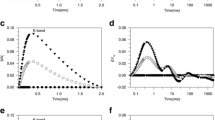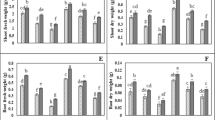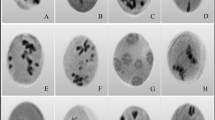Abstract
Heavy metal contamination is one of the most important abiotic stresses affecting physiological activities of plants. We investigated the effects of cadmium (Cd) and lead (Pb) on chlorophyll fluorescence (Fv/Fm, Fo, and Fm), photosynthetic pigments (chlorophyll a and b), and proline in one-year-old seedlings of Robinia pseudoacacia. The seedlings were treated twice over a period of 10 days with Cd and Pb at concentrations of 0, 250, 500, 1000 and 2000 mg L−1. Saline solution containing Cd and Pb was sprayed on the leaves. Chlorophyll and proline contents were measured after 10 days. Chlorophyll fluorescence of R. pseudoacacia was affected slightly by high concentrations (1000, 2000 mg L−1) of Cd and Pb. Chlorophyll a and a/b increased at 1000 and 2000 mg L−1 of Cd and proline content of leaves was similar in all treatments of Cd and Pb. Our results indicated that photosynthetic sensitivity of R. pseudoacacia to Cd and Pb contamination was weak. Photosystem II chlorophyll pigments were not damaged by Pb and Cd stress. We conclude that chlorophyll fluorescence along with chlorophyll and proline contents are useful indicators of Cd and Pb stresses in R. pseudoacacia which widely planted in urban polluted regions in Iran.


Similar content being viewed by others
References
Arnon DI (1949) Copper enzymes in isolated chloroplast polyphenol oxidase in Beta vulgaris. Plant Physiol 24:1–15
Ashraf M, Foolad MR (2007) Roles of glycine betaine and proline in improving plant abiotic stress resistance. Environ Exp Bot 59:206–216
Aspinall D, Paleg LG (1981) Proline accumulation: physiological aspects. The physiology and biochemistry of drought resistance in plants. Academic Press, Sydney, pp 205–241
Baryla AP, Carrier F, Franck C, Coulomb C, Sahut M (2001) Havaux, leaf chlorosis in oilseed rape plants (Brassica napus) grown on cadmium-polluted soil: causes and consequences for photosynthesis and growth. Planta 212:696–709
Bates LS, Waldron RP, Teare ID (1973) Rapid determination of free proline for water stress studies. Plant Soil 39:205–207
Baumann HA, Morrison L, Stengel DB (2009) Metal accumulation and toxicity measured by PAM Chlorophyll fluorescence in seven species of marine macroalgae. Ecotoxicol Environ Saf 72:1063–1075
Björkman O, Demmig B (1987) Photon yield of O2 evolution and chlorophyll fluorescence characteristics at 77 K among vascular plants of diverse origins. Planta 170:489–504
Burzyński M, Buczek J (1994) The influence of Cd, Pb, Cu and Ni on NO3 − uptake by cucumber seedlings. II. In vivo and in vitro effects of Cd, Pb, Cu and Ni on the plasma lemma ATPase and oxido reductase from cucumber seedlings roots. Acta Physiol Planta 16:297–302
Das P, Samantaray S, Rout GR (1997) Studies on cadmium toxicity in plants: a review. Environ Pollut 98:29–36
De Ell JR, Toivonen PMA (2003) Practical applications of chlorophyll fluorescence in plant biology. Kluwer Academic Publishers, London, pp 31–77
Delauney AJ, Verma DPS (1993) Proline biosynthesis and osmoregulation in plants. Planta 4:215–223
Dinakar N, Nagajyothi PC, Suresh S, Udaykiran Y, Damodharam T (2008) Phytotoxicity of cadmium on protein, proline and antioxidant enzyme activities in growing Arachis hypogaea L. seedlings. Environ Sci 20:199–206
Ekmekci Y, Deniz T, Beycan A (2008) Effects of cadmium on antioxidant enzyme and photosynthetic activities in leaves of two maize cultivars. Plant Physiol 165:600–611
El-Khatib AA, El-Swaf N (2001) Phytotoxicity of air particulate pollutants (dust) on the urban trees. Bull Fac Sci Assiut Univ Egypt 30:183–193
Frankart C, Eullaffroy P, Vernet G (2003) Comparative effects of four herbicides on non-photochemical fluorescence quenching in Lemna minor. Environ Exp Bot 49:159–168
Genty B, Briantais JM, Baker NR (1989) The relationship between the quantum yield of photosynthetic electron transport and quenching of chlorophyll fluorescence. Biochem Biophys Acta 99:87–92
Gülriz B, Doganay T, Hakan O, Süreyya G (2006) Ecophysiological and seasonal variations in Cd, Pb, Zn, and Ni concentrations in the leaves of urban deciduous trees in Istanbul. Environ Pollut 143:545–554
Hare PD, Cress WA (1997) Metabolic implications of stress induced proline accumulation in plants. Plant Growth Regul 21:79–102
Jones RJ, Kildea T, Hoegh-Guldberg O (1999) PAM chlorophyll fluorometry: a new in situ technique for stress assessment in scleractinian corals, used to examine the effect of cyanide from cyanide fishing. Mar Pollut Bull 38:864–874
Joshi PC, Swami A (2009) Air pollution induced changes in the photosynthetic pigments of selected plant species. Environ Biol 30:295–298
Kabata-Pendias A, Pendias H (1986) Trace elements in soils and plants. CRC Press Inc, Boca Raton, p 315
Kitajima M, Butler WL (1975) Quenching of chlorophyll fluorescence and primary photochemistry in chloroplasts by dibromothymoquinone. Biochem Biophys Acta 376:105–115
Kopittke PM, Pax F, Blamey C, Colin J, Neal A, Menzies W (2010) Trace metal phytotoxicity in solution culture: a review. J Exp Bot 61:945–954
Kramer PJ, Kozlowski TT (1979) Physiology of woody plants. Academic Press, Orlando, p 811
Küpper H, Küpper FC, Spiller M (1996) Environmental relevance of heavy metal-substituted chlorophylls using the example of water plants. J Exp Bot 47:259–266
Levitt J (1980) Response of plant to environmental stress, 2nd edn. Academic press, New York, p 497
Lewis S, Donkin ME, Depledge MH (2001) Hsp 70 expression in Enteromorpha intestinalis (Chlorophyta) exposed to environmental stress. Aquat Bot 51:277–291
Lichtenthaler and Rinderle (1988) The role of chlorophyll fluorescence in the detection of stress condition in plants. CRC Crit Rev Anal Chem 19:529–585
Mallick N, Mohn FH (2003) Use of chlorophyll fluorescence in metal-stress research: a case study with the green microalga Scenedesmus. Ecotoxicol Environ Saf 55:64–69
Maxwell K, Johnson GN (2000) Chlorophyll fluorescence a practical guide. Exp Bot 51:659–668
Nielsen HD, Brownlee C, Coelho SM, Brown MT (2003) Inter population difference in inherited copper tolerance involve photosynthetic adaptation and exclusion mechanisms in Fucus serratus. New Phytol 160:157–165
Olivars E (2003) The effect of lead on the phytochemistry of Tithonia diversifolia exposed to roadside automotive pollution or grown in pots of Pb-supplemented soil. Braz Plant Physiol 15:149–158
Ouzounidou G, Moustakas M, Eleftheriou EP (1997) Physiological and ultrastructural effects of cadmium on wheat (Triticum aestivum L.) leaves. Arch Environ Contam Toxicol 32:154–160
Prasad MNV, Strzalka K (1999) Impact of heavy metals on photosynthesis. In: Prasad MNV, Hagemeyer J (eds) Heavy metal stress in plants. Springer, Heidelberg, pp 117–138
Rahmonov O (2009) The chemical composition of plant litter of black locust (Robinia pseudoacacia L.) and its ecological role in sandy ecosystems. Acta Ecol Sin 29:237–243
Ralph PJ, Burchett MD (1998) Photosynthetic response of Halophila ovalis to heavy metal stress. Environ Pollut 103:91–101
Rascio N, Vecchia FD, Ferretti M, Merlo L, Ghisi R (1993) Some effects of cadmium on maize plants. Environ Contam Toxicol 25:244–249
Sawidis T, Chettri MK, Papaioannou A, Zachariadis A, Stratis J (2001) A study of metal distribution from lignite fuels using tree as biological monitors. Ecotoxicol Environ Saf 48:27–35
Schat H, Sharma SS, Vooijs R (1997) Heavy metal-induced accumulation of free proline in metal-tolerant and non-tolerant ecotypes of Silene vulgaris. Physiol Plant 10:477–482
Schreiber U, Bilger W, Neubauer C (1994) Chlorophyll fluorescence as a non-intrusive indicator for rapid assessment of in vivo photosynthesis. In: Schulze ED, Caldwell MM (eds) Ecophysiology of photosynthesis. Springer, Berlin, pp 49–70
Seyyednejad SM, Niknejad M, Yusefi M (2009) Study of air pollution effects on some physiology and morphology factors of Albizia lebbeck in high temperature condition in Khuzestan. Plant Sci 4:122–126
Stiborova M, Dubravova M, Brezinova A, Friedrich A (1986) Effect of heavy metal ions on growth and biochemical characteristics of photosynthesis of barley. Photosynthetica 20:418–425
Tanyolac D, Ekmekci Y, Ünalan S (2007) Changes in photochemical and antioxidant enzyme activities in maize (Zea mays L.) leaves exposed to excess copper. Chemosphere 67:89–98
Tripathi AK, Gautam M (2007) Biochemical parameters of plants as indicators of air pollution. Environ Biol 28:127–132
Vassilev A, Yordanov I, Tsonev T (1997) Effects of Cd2+ on the physiological state and photosynthetic activity of young barely plants. Photosynthetica 34:293–302
Acknowledgements
We thank Iran Research Institute of Forests and Rangelands as well as the Laboratory of Horticultural Sciences of the University of Tehran, for their financial and technical supports. Suggestions offered by anonymous referees are highly appreciated.
Author information
Authors and Affiliations
Corresponding author
Additional information
Project funding: This paper was supported by Iran Research Institute of Forests and Rangelands and the Laboratory of Horticultural Sciences of the University of Tehran.
The online version is available at http:// www.springerlink.com
Corresponding editor: Zhu Hong
Rights and permissions
About this article
Cite this article
Dezhban, A., Shirvany, A., Attarod, P. et al. Cadmium and lead effects on chlorophyll fluorescence, chlorophyll pigments and proline of Robinia pseudoacacia . J. For. Res. 26, 323–329 (2015). https://doi.org/10.1007/s11676-015-0045-9
Received:
Accepted:
Published:
Issue Date:
DOI: https://doi.org/10.1007/s11676-015-0045-9




